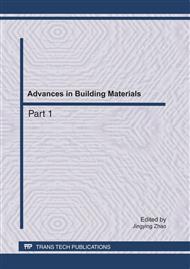[1]
Zivanovic S, Pavic A, Reynolds P. Vibration serviceability of footbridges under human-induced excitation: a literature review[J].Journal of Sound and Vibration. Vol. 279(2005), pp.1-74
DOI: 10.1016/j.jsv.2004.01.019
Google Scholar
[2]
Song Zhi-gang. A new annoyance-based vibration comfort design theory on engineering structures [D]. Hangzhou: Zhejiang University (2003).
Google Scholar
[3]
Song Zhi-gang, Jin Wei-liang. Vibration serviceability analysis of floor structures under pedestrian loads [J.]. Journal of vibration engineering, Vol. 18(2005), p.288~292
Google Scholar
[4]
Stana Zivanovic, Aleksandar Pavic, Paul Reynolds. Probability-based prediction of multi-mode vibration response to walking excitation[J]. Engineering Structures Vol. 29(2007), p.942–954
DOI: 10.1016/j.engstruct.2006.07.004
Google Scholar
[5]
Fa Yong-sheng, LI Dong, Sun Cui-hua. Vibration analysis for a footbridge under stochastic pedestrian loan and a new method for comfort evaluation [J]. Journal of vibration and shock, Vol. 27 (2008), pp.119-123
Google Scholar
[6]
H Bachmann, Ammann W. Vibration in structures induced by man and machines. Structural engineering documents 3e. Zurich: International association of bridge and structural engineering (IABSE) (1987).
Google Scholar
[7]
CSA. Canadian highway bridge design code[S]. CAN/CSA-S6-00. Canadian Standards Association (2000).
Google Scholar
[8]
Song Zhi-gang, Jin Wei-liang. Peak acceleration response spectrum of long span floor vibration by pedestrian excitation [J]. Journal of Building Structure, Vol. 25(2004), pp.57-63
Google Scholar
[9]
Kerr SC. Human induced loading on staircases [D]. UK Mechanical Engineering Department, University College London (1998).
Google Scholar
[10]
Brownjohn JMW, Pavic A, Omenzetter P. A spectral density approach for modeling continuous vertical forces on pedestrian structures due to walking [J]. Canadian Journal of Civil Engineering Vol. 24(2004), p.65–77.
DOI: 10.1139/l03-072
Google Scholar
[11]
Fang Kai-tai., Ma Chang-xin. Orthogonal and uniform experimental design [M]. Beijing: Science press (2001).
Google Scholar
[12]
Fang Kai-tai. Uniform design [J]. Tactical missile technology, Vol. 6(1994).
Google Scholar
[13]
H. Bachmann, A.J. Pretlove, H. Rainer.Vibrations induced by people, in: Vibration Problems in Structures: Practical Guidelines, Birkhauser Verlag, Basel (1995).
DOI: 10.1007/978-3-0348-9231-5_1
Google Scholar
[14]
Zhao Guo-fan, Jin Wei-liang, Gong jin-xin. The theory of structure reliability [M]. Bejing: China Architecture and Building press (2000).
Google Scholar


